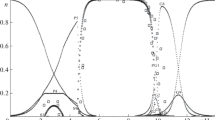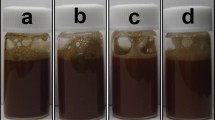Abstract
A general graphical approach to the solution chemistry of chemical mechanical polishing is presented with the aid of a variety of aqueous stability diagrams, such as Eh-pH (Pourbaix), log Metal-pH, and log Ligand-pH diagrams. The common thermodynamic origin of these diagrams is highlighted. The important role played by concentration gradients in effecting chemical mechanical polishing is stressed and illustrated with the aid of stability diagrams generated for the Cu-H2O and Cu-NH3-H2O model systems. It is demonstrated that chemical mechanical polishing is feasible when the following two conditions are satisfied simultaneously: (a) at the metal surface dissolved metal concentration is high and/or ligand concentration is low (this favors oxide film formation), and (b) in the bulk aqueous phase the metal concentration is low and/or the ligand concentration is high (this favors the dissolution of film fragments).
Similar content being viewed by others
References
S.P. Murarka, J. Steigerwald and R. J. Gutmann,MRS Bull. (6), 46 (1993).
F. Pintchovski,IEEE IEDM Tech. Dig. 97 (1994).
J. Torres,Appl. Surf. Sci. 91, 112 (1995).
L.C. Parrillo,Advanced Metallization for ULSI Applications in 1994, eds. R. Blumenthal and G. Janssen, (Pittsburgh, PA: Mater. Res. Soc., 1995), p. 3.
C. Steinbrüchel,Appl. Surf. Sci. 91, 139 (1995).
J.M. Steigerwald, S.P. Murarka, R.J. Gutmann and D.J. Duquette,Mater. Chem. and Phys. 41, 217 (1995).
R.J. Gutmann, J.M. Steigerwald, L. You, D.T. Price, J. Neirynck, D.J. Duquette and S.P. Murarka,Thin Solid Films 270, 596 (1995).
J.M. Steigerwald, D.J. Duquette, S.P. Murarka and R.J. Gutmann,J. Electrochem. Soc. 142, 2379 (1995).
J.M. Steigerwald, S. Murarka, R.J. Gutmann and D.J. Duquette,J. Electrochem. Soc. 141, 3512 (1994).
J.M. Steigerwald, R. Zirpoli, S. Murarka, D. Price and R.J. Gutmann,J. Electrochem. Soc. 141, 2842 (1994).
J.M. Steigerwald, S.P. Murarka, D.J. Duquette and R.J. Gutmann,Advanced Metallization for Devices and Circuits Science, Technology and Manufacturability, eds. S.P. Murarka, A. Katz, K.N. Tu and K. Maex, 337 (Pittsburgh, PA: Mater. Res. Soc., 1994), p. 133.
M. Pourbaix,Atlas of Electrochemical Equilibria in Aqueous Solutions, London: Pergamon, 1966).
W. Stumm and J.J. Morgan,Aquatic Chemistry, 2nd ed., (New York: Wiley, 1981).
K. Osseo-Asare, D. Wei and K.K. Mishra,J. Electrochem. Soc. 143, 749 (1996).
K. Osseo-Asare, D. Wei and K. Mishra,Cleaning Technology in Semiconductor Device Manufacturing, eds. J. Ruzyllo and R.E. Novak, PV 94-7 (Pennington, NJ: Electrochem. Soc., 1994), p. 34.
K. Osseo-Asare and T.H. Brown,Hydrometallurgy 4, 217 (1979).
D.D. Wagman, W.H. Evans, V.B. Parker, R.H. Schumm, I. Halow, S.M. Bailey, K.L. Churney and R.L. Nuttall,J. Phys. Chem. Ref. Data 11, Suppl. No. 2 (1982).
G.B. Naumov, B.N. Ryzhenko and I.L. Khodakovsky,Handbook of Thermodynamic Data (Moskow: Atomizdat, 1971). Translated from the Russian by the U.S. Geological Survey. NTIS PB-226 722, 1974.
R.M. Smith and A.E. Martell,Critical Stability Constants Vol. 4 (New York: Plenum, 1977).
CF. Baes, Jr. and R.E. Mesmer,The Hydrolysis of Cations (New York: Wiley, 1976).
W.J.M. Tegart,The Electrolytic and Chemical Polishing of Metals in Research and Industry 2nd ed., (New York: Pergamon, 1959).
P.A. Jacquet,Metall. Rev. 1, 157 (1956).
A. Hickling and J.K. Higgins,Trans. Inst. Met. Finish. 29,274 (1953).
J. Halpern,J. Electrochem. Soc. 100, 421 (1953).
M.J. Nicol,J. South Afric. Inst. Min. Metall. 291 (1975).
Author information
Authors and Affiliations
Rights and permissions
About this article
Cite this article
Osseo-Asake, K., Mishra, K.K. Solution chemical constraints in the chemical-mechanical polishing of copper: Aqueous stability diagrams for the Cu-H2O and Cu-NH3-H2O systems. J. Electron. Mater. 25, 1599–1607 (1996). https://doi.org/10.1007/BF02655582
Received:
Accepted:
Issue Date:
DOI: https://doi.org/10.1007/BF02655582




